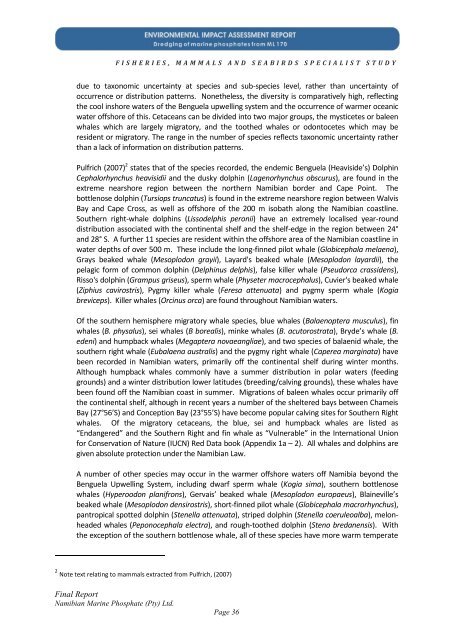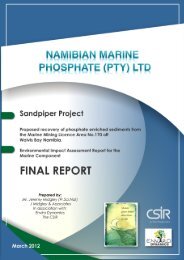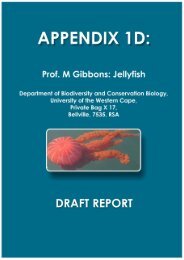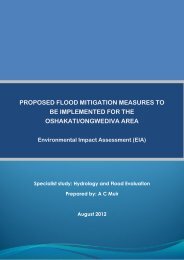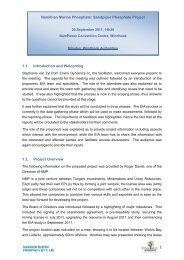Fisheries - Enviro Dynamics Namibia
Fisheries - Enviro Dynamics Namibia
Fisheries - Enviro Dynamics Namibia
Create successful ePaper yourself
Turn your PDF publications into a flip-book with our unique Google optimized e-Paper software.
F I S H E R I E S , M A M M A L S A N D S E A B I R D S S P E C I A L I S T S T U D Y<br />
due to taxonomic uncertainty at species and sub-species level, rather than uncertainty of<br />
occurrence or distribution patterns. Nonetheless, the diversity is comparatively high, reflecting<br />
the cool inshore waters of the Benguela upwelling system and the occurrence of warmer oceanic<br />
water offshore of this. Cetaceans can be divided into two major groups, the mysticetes or baleen<br />
whales which are largely migratory, and the toothed whales or odontocetes which may be<br />
resident or migratory. The range in the number of species reflects taxonomic uncertainty rather<br />
than a lack of information on distribution patterns.<br />
Pulfrich (2007) 2 states that of the species recorded, the endemic Benguela (Heaviside’s) Dolphin<br />
Cephalorhynchus heavisidii and the dusky dolphin (Lagenorhynchus obscurus), are found in the<br />
extreme nearshore region between the northern <strong>Namibia</strong>n border and Cape Point. The<br />
bottlenose dolphin (Tursiops truncatus) is found in the extreme nearshore region between Walvis<br />
Bay and Cape Cross, as well as offshore of the 200 m isobath along the <strong>Namibia</strong>n coastline.<br />
Southern right-whale dolphins (Lissodelphis peronii) have an extremely localised year-round<br />
distribution associated with the continental shelf and the shelf-edge in the region between 24°<br />
and 28° S. A further 11 species are resident within the offshore area of the <strong>Namibia</strong>n coastline in<br />
water depths of over 500 m. These include the long-finned pilot whale (Globicephala melaena),<br />
Grays beaked whale (Mesoplodon grayii), Layard's beaked whale (Mesoplodon layardii), the<br />
pelagic form of common dolphin (Delphinus delphis), false killer whale (Pseudorca crassidens),<br />
Risso's dolphin (Grampus griseus), sperm whale (Physeter macrocephalus), Cuvier's beaked whale<br />
(Ziphius cavirostris), Pygmy killer whale (Feresa attenuata) and pygmy sperm whale (Kogia<br />
breviceps). Killer whales (Orcinus orca) are found throughout <strong>Namibia</strong>n waters.<br />
Of the southern hemisphere migratory whale species, blue whales (Balaenoptera musculus), fin<br />
whales (B. physalus), sei whales (B borealis), minke whales (B. acutorostrata), Bryde’s whale (B.<br />
edeni) and humpback whales (Megaptera novaeangliae), and two species of balaenid whale, the<br />
southern right whale (Eubalaena australis) and the pygmy right whale (Caperea marginata) have<br />
been recorded in <strong>Namibia</strong>n waters, primarily off the continental shelf during winter months.<br />
Although humpback whales commonly have a summer distribution in polar waters (feeding<br />
grounds) and a winter distribution lower latitudes (breeding/calving grounds), these whales have<br />
been found off the <strong>Namibia</strong>n coast in summer. Migrations of baleen whales occur primarily off<br />
the continental shelf, although in recent years a number of the sheltered bays between Chameis<br />
Bay (27°56’S) and Conception Bay (23°55’S) have become popular calving sites for Southern Right<br />
whales. Of the migratory cetaceans, the blue, sei and humpback whales are listed as<br />
“Endangered” and the Southern Right and fin whale as “Vulnerable” in the International Union<br />
for Conservation of Nature (IUCN) Red Data book (Appendix 1a – 2). All whales and dolphins are<br />
given absolute protection under the <strong>Namibia</strong>n Law.<br />
A number of other species may occur in the warmer offshore waters off <strong>Namibia</strong> beyond the<br />
Benguela Upwelling System, including dwarf sperm whale (Kogia sima), southern bottlenose<br />
whales (Hyperoodon planifrons), Gervais’ beaked whale (Mesoplodon europaeus), Blaineville’s<br />
beaked whale (Mesoplodon densirostris), short-finned pilot whale (Globicephala macrorhynchus),<br />
pantropical spotted dolphin (Stenella attenuata), striped dolphin (Stenella coeruleoalba), melonheaded<br />
whales (Peponocephala electra), and rough-toothed dolphin (Steno bredanensis). With<br />
the exception of the southern bottlenose whale, all of these species have more warm temperate<br />
2 Note text relating to mammals extracted from Pulfrich, (2007)<br />
Final Report<br />
<strong>Namibia</strong>n Marine Phosphate (Pty) Ltd.<br />
Page 36


